In today’s digital landscape, data is king, and leveraging it effectively can make or break your advertising efforts. If your Facebook Ads account is already well-optimised, the next step to significantly boost performance is integrating your CRM system. In the age of AI, the more data you provide, the better your ads can be optimised, ensuring your advertising spend drives real results.
With data sources becoming the cornerstone of modern advertising platforms, integrating your CRM allows for a more comprehensive understanding of your customer journey, helping you enhance lead tracking and measurement, improve lead quality, and ultimately increase sales. This blog will explore the various methods to connect your CRM to Facebook Ads, from cost-effective solutions to premium offerings, and provide a detailed guide to making this connection work for your business. Whether you are looking to use tools like Zapier or rely on native integrations like HubSpot or Salesforce, we’ll cover the steps and strategies needed to get the most from your CRM and advertising integration.
We will explore both low-cost solutions and premium options to suit larger budgets. For instance, the most affordable solution can be implemented for as little as £20 ($30) per month in software fees. We’ll also explain how to use Zapier to integrate your CRM with Facebook Ads, using HubSpot as an example. If your CRM cannot integrate with Facebook Ads via Zapier, we will also cover how HubSpot can be utilised without the need for Zapier.

Choosing the Right Facebook Ads Integration for Your CRM
Before exploring Facebook Ads CRM integration in detail, it is essential to understand the various scenarios in which businesses might choose between different integration options. These include using tools like Zapier to connect an existing CRM system, selecting a CRM with built-in Facebook Ads integration (such as HubSpot or Salesforce), a combination of Zapier and native CRM integration, or directly utilising Facebook’s API. Another option is to use a system with built-in Facebook Ads integration solely as a marketing automation platform that connects to your existing CRM. You might want to do this if your CRM is built in-house, with stakeholders across other departments.
1.) Using Zapier to Connect your Current CRM To Facebook Ads
If your CRM does not have its integration with Facebook Ads, and you want a low-cost solution then check out Zapier a cost-effective marketing automation and integration cloud-based tool.
Zapier makes it easy to integrate online the most popular online apps, including most leading CRMs.
With Zapier, you can send offline conversions from your current CRM’s sales cycle stages to Facebook Ads and sync your updated customer and prospect lists from your current CRM as audiences for Facebook Ads.
Numerous other options are available, depending on the number of Zap templates supported by your CRM. For example, you can capture leads directly from Facebook using Lead Ads on Facebook, and automate follow-up processes, among other features.
Zapier starts at around 25/30 dollars per month. We shall cover Zapier in-depth in this blog post, but if you are still not comfortable setting up the integration, One PPC is here to be of service.
The below illustration shows a “Zap”- a workflow integration between HubSpot and Facebook Ads to send offline conversions. The list is a stage of the HubSpot contact (lead) lifecycle.
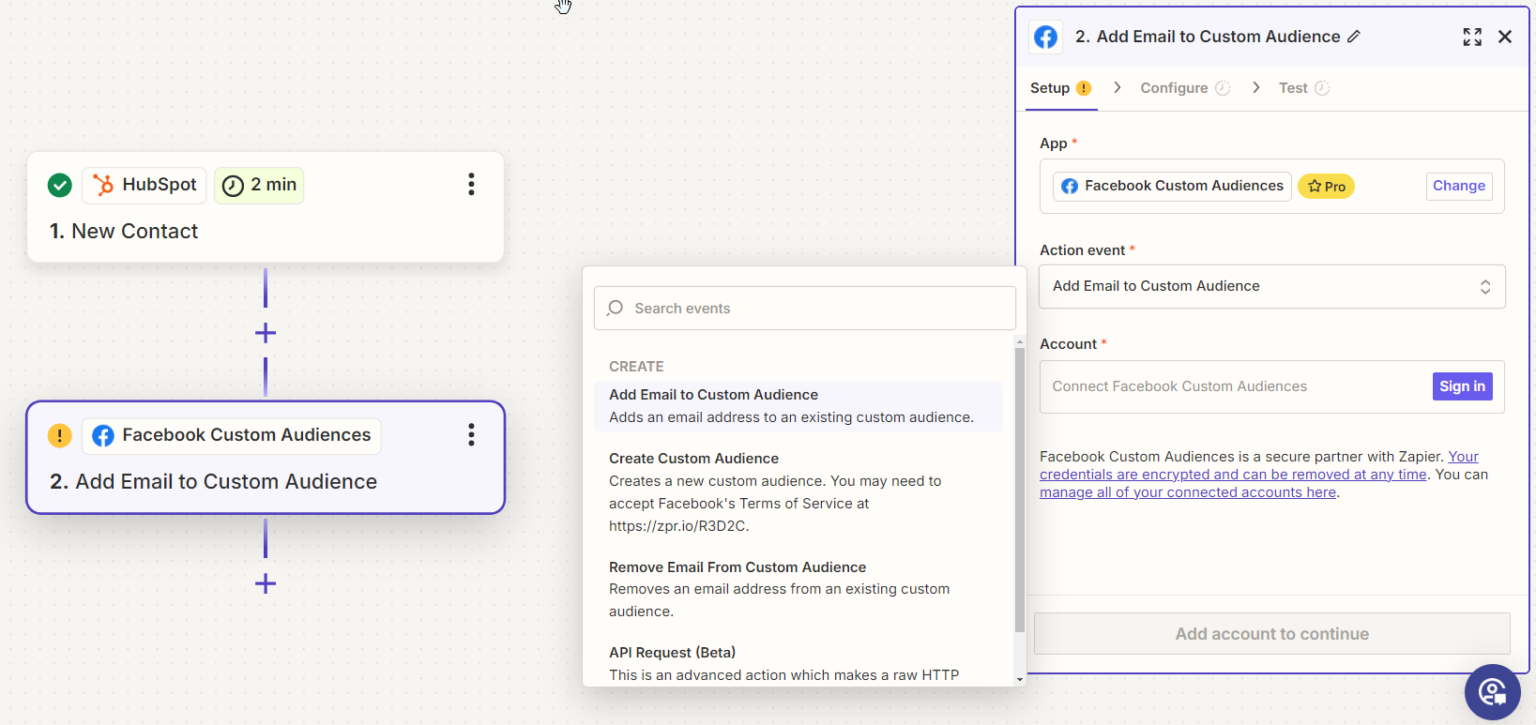
2) Native CRM Integration with Facebook Ads (e.g. - HubSpot Pro Marketing, Salesforce Pardot):
Some CRMs, such as HubSpot and SalesForce offer prebuilt out-of-the-box integration with Facebook Ads, making the setup straightforward and quick.
These platforms often provide robust analytics and marketing automation tools that are deeply integrated with Facebook Ads, enhancing the capabilities beyond just data syncing (e.g. Zapier or basic API integration). This option is the most expensive, but is the most comprehensive – and easier to justify as your ad spend increases. We shall cover some lower-cost approaches next.
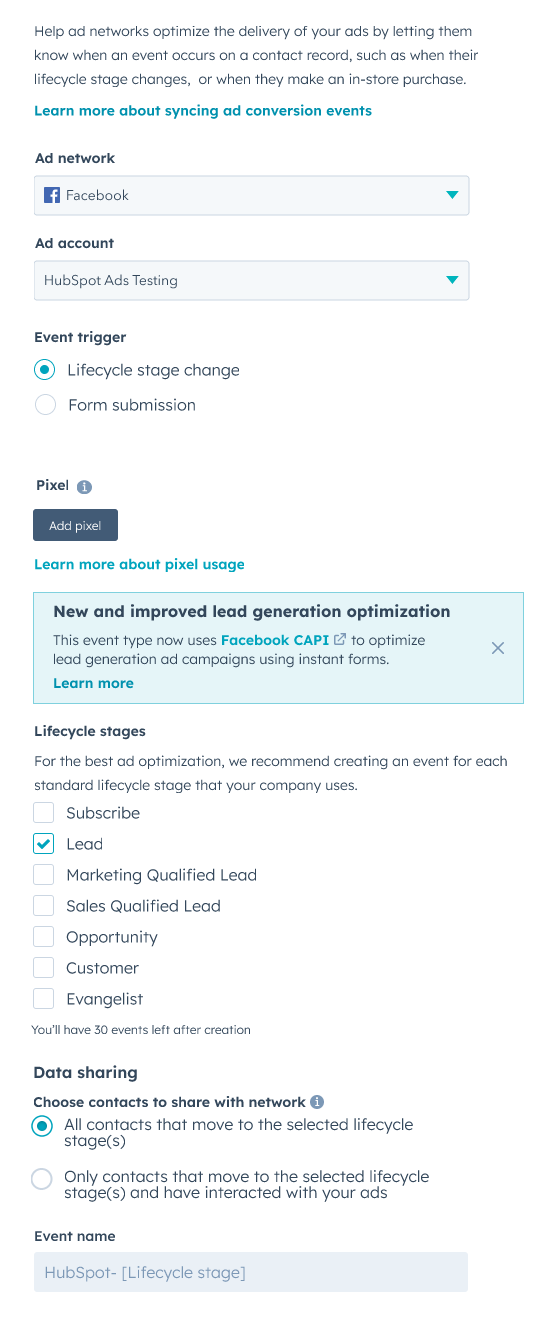
3) Using a Combination of Zapier & Native CRM:
It should be noted that the Starter edition of both HubSpot and SalesForce will lack some Facebook Ads integration features, so if you don’t have the budget to upgrade – you can use Zapier to complement these available starter functions. HubSpot Starter begins at $30 dollars/£25 pounds per month, and Zapier is around the same price.
Even with more expensive editions of CRMs like HubSpot Pro/Enterprise or Salesforce Pardot, there may be instances where native integrations do not cover specific functionalities. Here, Zapier can fill the gap, extending the capabilities of your CRM system. As stated above, Starter editions of many CRMs have fewer integration options and can instead use Zapier if they do not have the budget to upgrade to a higher edition license.
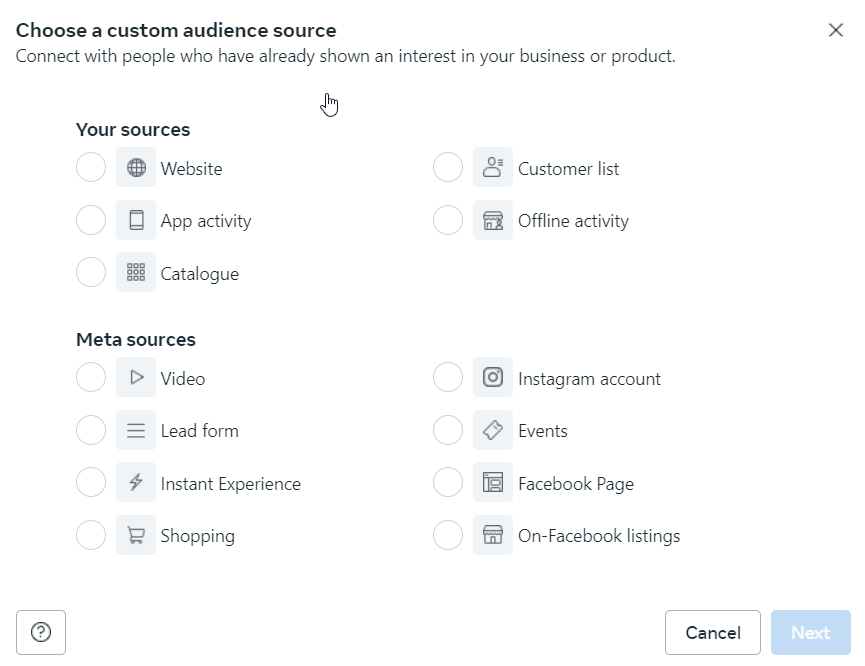
4.) Direct Integration Using's Facebook's API:
Larger enterprises with dedicated development teams might opt for Facebook‘s API to create a highly customised integration. For example, if you have developed your own CRM in-house for your unique requirements. This approach requires significant technical resources and time.
Larger enterprises with dedicated development teams might opt for Facebook’s API to create a highly customised integration. For example, if you have developed your own CRM in-house for your unique requirements. This approach requires significant technical resources and time.
5) Using a Marketing Automation System and Integrating it with your current CRM
If you have an in-house developed CRM, Zapier won’t have premade templates for integrating with Facebook Ads. This leaves you with the option of using Facebook‘s API. However, there is another option to consider: you can retain your existing CRM while using a system like HubSpot purely as a marketing automation tool that connects to it. For example, many companies that use Salesforce integrate HubSpot Marketing Hub as part of their overall solution
Considerations in the Choice of a CRM:
If you don’t have a CRM or are dissatisfied with your current one, it may be worthwhile to consider a system like HubSpot or Salesforce, which offer out-of-the-box integration with Facebook Ads. This can be especially beneficial if Facebook Ads is your primary source of leads and sales. These platforms not only provide advanced features, but also eliminate the need for additional tools due to their built-in Facebook Ads integration.
Take-aways
Choosing the right integration method depends largely on your business size, technical capacity, specific needs, advertising budget and the strategic importance of Facebook Ads in your marketing efforts. Each option offers distinct advantages and potential limitations, making it essential to assess which integration aligns best with your organizational goals and resources.
In this blog post, we are going to focus on using Zapier to integrate your CRM with Facebook Ads, and we shall use the HubSpot starter edition as an example CRM.
What is Facebook Ads Integration with CRM?
Integrating Facebook Ads with a Customer Relationship Management (CRM) system is a strategy that aligns your digital advertising campaigns with detailed customer insights stored within the CRM. This integration allows UK businesses to enhance their marketing efforts in several key ways:
Data Sharing: This integration facilitates the seamless exchange of information between Facebook Ads and the CRM system. For example, when a potential customer interacts with an ad and completes a form, their details are automatically stored in the CRM, where they can be managed and nurtured effectively.
Offline Conversion Tracking (OCT): By connecting Facebook Ads with the CRM, it’s possible to accurately track conversions that are initiated from ads. This involves importing conversion data from the CRM back to Facebook Ads, offering a more detailed analysis of campaign effectiveness.
Audience Targeting and Personalisation: Access to detailed CRM data enables businesses to create highly personalised and targeted ad campaigns. This data allows for segmentation of audiences based on previous interactions, purchases, or behaviours, which can then be utilised to customise the advertising experience on Facebook Ads.
Enhanced ROI Measurement: Integrating Facebook Ads with your CRM system enables you to attribute revenue and other conversion metrics directly to specific campaigns, providing a clearer picture of the return on investment (ROI) from your advertising expenditures.
Optimisation and Automation: This integration can lead to better optimisation and automation of marketing efforts. For instance, certain customer actions recorded in the CRM, like a recent purchase or expressed interest in a product, can automatically trigger specific, tailored advertising campaigns on Facebook Ads.
Overall, integrating Facebook Ads with CRM systems closes the gap between marketing and sales, ensuring that advertising efforts are supported by the most current and comprehensive customer data. This leads to more efficient marketing spend and an enhanced customer experience, driving better business outcomes.

Benefits of Using CRM Ads with Facebook Ads
Integrating HubSpot Ads with Facebook Ads can significantly enhance your advertising strategy by leveraging own data alongside the targeting abilities provided by Facebook Ads. Here are the key benefits of using HubSpot Ads with Facebook Ads:
Improve Lead Quality:
Lead quality optimisation is perhaps the primary reason to connect your CRM to Facebook Ads. If you rely solely on online conversion tracking for Facebook Ads, you are optimising for the highest quantity of leads without considering their quality. This is true whether you use automatic or manual bidding with campaign objectives lower in the funnel such as Lead Ads or Website conversions.
By using offline conversion tracking, you can sync lead stage changes (contact lifecycle) back to the ad platform to score lead quality.
This lets Facebook Ads know which leads are more likely to progress into customers and are therefore of the highest quality.
For example, if you group your leads into good, average, and poor categories, you can train Facebook‘s AI to acquire more high-quality leads and fewer poor leads by using offline event tracking (Changes in lead stage). Optimise your ads with automatic bidding (machine learning) to focus on acquiring high-quality leads, ensuring the AI prioritises the best quality leads, thereby reducing lower-quality leads.
This approach ensures that your advertising efforts yield more valuable leads, ultimately improving your campaign’s overall effectiveness and ROI.
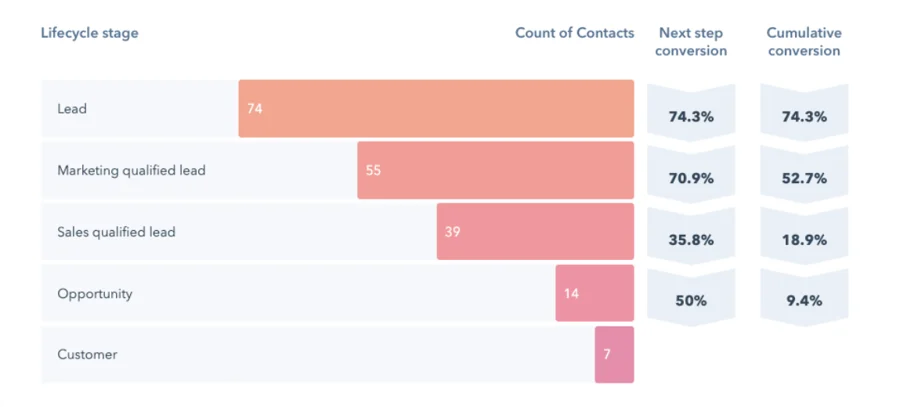
Improved Measurement, Tracking and Reporting
Most companies are eager to increase their advertising spend; however, they also seek to ensure they are achieving the highest possible return on investment (ROI). With many interactions and sales comprising both online and offline activities, it becomes challenging to discern what is effective and what is not.
By leveraging the combined reporting capabilities of Facebook and your CRM first-party data, you can refine your advertising efforts, attain superior outcomes, and drive business growth. This integration furnishes valuable insights and tools to amplify the impact of your Facebook Ads campaigns using your proprietary data.
A CRM like HubSpot amalgamates Facebook‘s data with your contact database, providing a cohesive view of your campaign performance. This integration enables you to make informed decisions and hone your strategy by monitoring both standard online metrics, such as click-through rates and conversions, and offline metrics related to your sales funnel progression. These metrics encompass cost per Marketing Qualified Lead (MQL), Sales Qualified Lead (SQL), deal, customer, and overall advertising ROI.
This comprehensive approach to reporting ensures you have a lucid understanding of your campaign’s efficacy across all stages of the sales funnel.
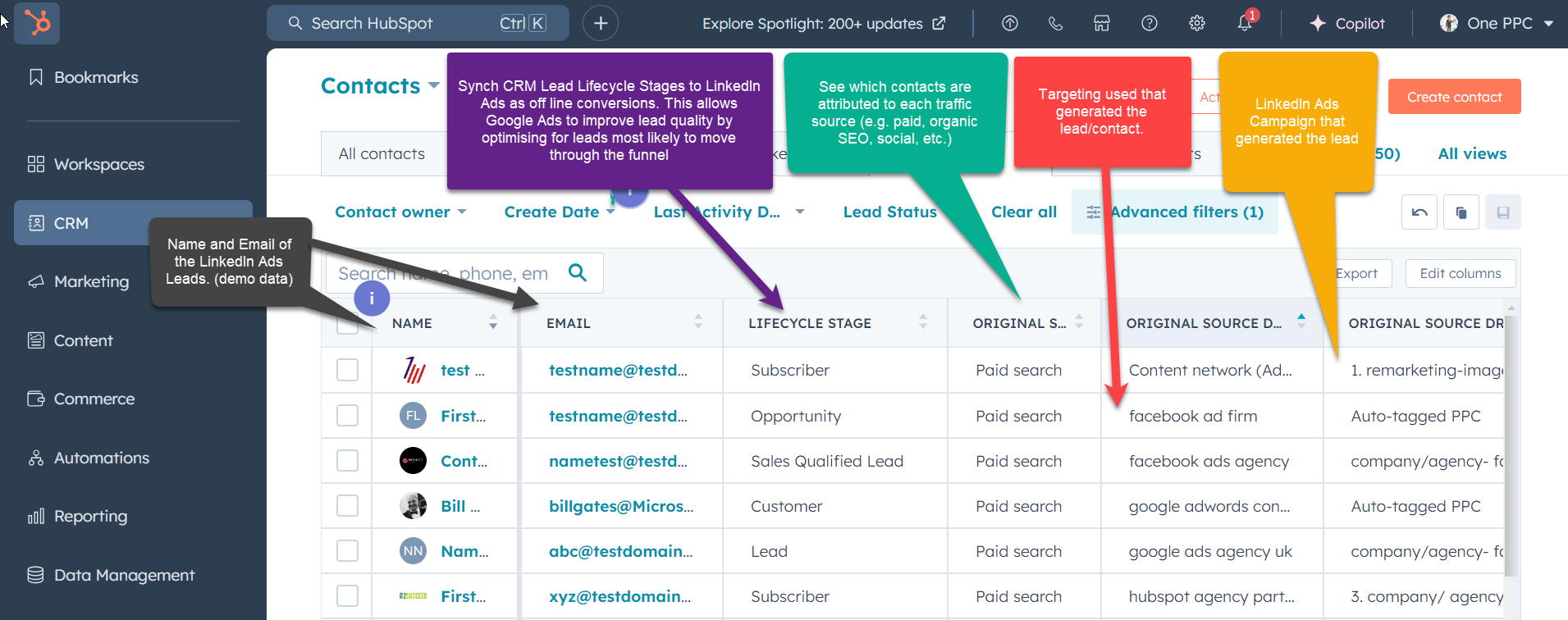
Audience Targeting Improvements
Facebook offers a range of retargeting options, including email, website cookies and companies lists to reach people who have already interacted with your brand, such as through a website visit or a marketing event.
To go beyond the standard targeting options within Facebook Ads, CRM list refine your messaging to reach the right person at the right time. Share lists from your CRM to Facebook, including contact emails and website cookies. This approach expands your reach to cold traffic and strengthens your retargeting efforts. Build a funnel on Facebook to nurture leads before capturing their details with a lead form on Facebook or your website.
Using HubSpot as a CRM example, it integrates with Facebook to share targeting lists created in HubSpot, including contact lists, company lists (Target Accounts) and website cookie list users. You can combine these audiences with Facebook‘s audience targeting to retarget warm traffic that already knows your brand. Utilise HubSpot’s segmentation tools to create highly targeted audience lists based on detailed criteria such as:
- When filter criteria are met: Objects will enrol when the criteria are true. For example, when a contact’s city is “Berlin,” they can be included on a list with a geographic targeting filter.
- When an event occurs: Objects will enrol when an event has happened, such as when a form is submitted or a contact revisits your website.
- HubSpot also allows you to automatically email a contact if they return to your website, enhancing retargeting effectiveness.
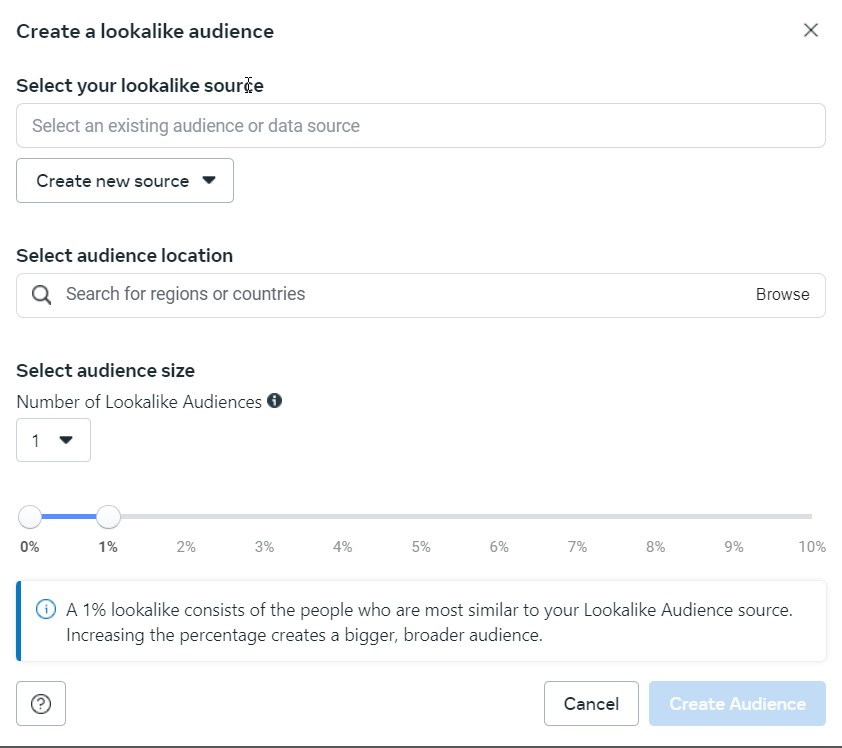
Nurturing Down the Funnel
CRM integration allows advertisers to nurture leads further down the funnel using retargeting strategies. Using HubSpot CRM as an example,
Website Retargeting: HubSpot enables you to set up retargeting campaigns for users who have visited your website. This helps re-engage users who have shown interest in your brand but have not yet converted.
Contact Retargeting: Use HubSpot to build customer lists for retargeting on Facebook, including uploading lists of prospect contacts or specific customers you want to target. Once you have captured their contact details, you can use workflows to deliver targeted content and follow-up messages based on user behaviour and engagement history.
Company Retargeting : Facebook Ads offer a unique opportunity to retarget professionals based on their job titles, industries, or company sizes, enhancing B2B marketing efforts. By combining CRM data with Facebook’s professional audience, you can refine your targeting to reach decision-makers more effectively.
By leveraging these retargeting strategies, you can effectively guide prospects through the buyer’s journey, increasing the likelihood of conversion and enhancing overall campaign performance.
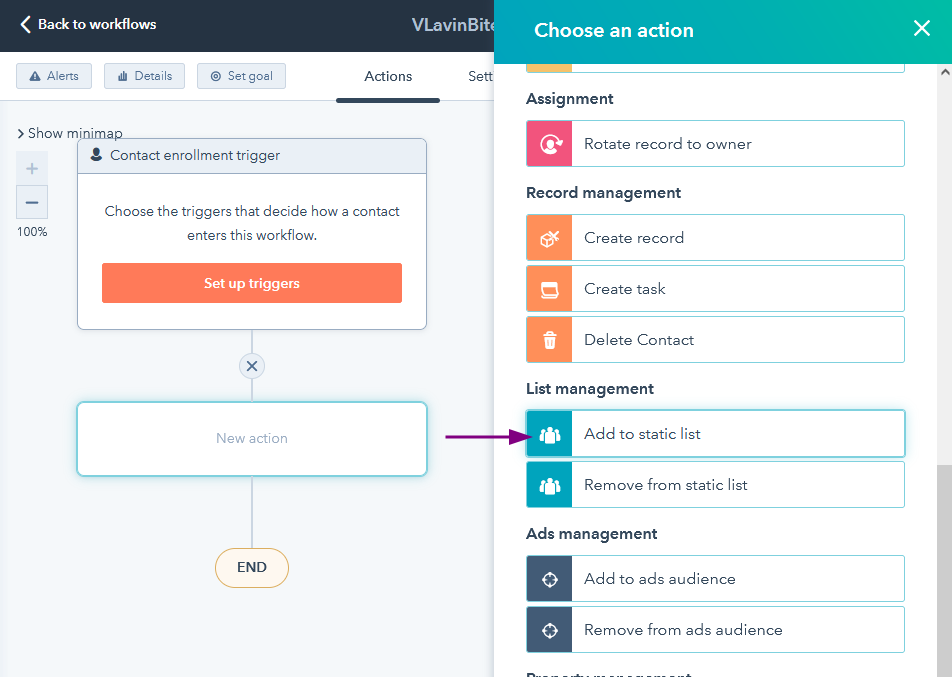
CRM Integration Capabilities
CRM integration provides a comprehensive set of functionalities that are not available when advertising campaigns are run without CRM integration. By offering features that align with Facebook Ads best practices, CRM integration can greatly enhance your advertising efforts.
Here’s how CRM integration can help advertisers implement these best practices effectively
Leverage Both Online & Offline Conversion Tracking to Enhance Lead Quantity and Quality
Conversion tracking is a vital tool in Facebook Ads for measuring success and improving campaign performance to enhance profitability and increase customer sales. Facebook Ads offers both online and offline conversion tracking.
Facebook Ads Online conversion tracking helps increase lead quantity,
while Facebook Ads offline conversion tracking helps improve lead quality.
Most advertisers use online conversion tracking to measure the number of leads generated and the cost per lead. However, more companies are now extending this approach by incorporating offline conversion tracking, as recommended by Facebook, to gain deeper insights into lead quality and optimise deeper into the funnel than just the initial lead event (conversion).
Online Tracking (Facebook Ads Conversion Tracking):
Facebook Ads records the number of people who fill out a form on your website as an online conversion, using the Facebook Ads online conversion tracking script (Pixel/Dataset Tag) placed on your site.
Success is measured by the quantity of leads and the cost per lead, which only considers the first step in your sales process (the lead enquiry).
Lead Ads come with a built-in online tracking system since the forms are hosted directly on Facebook. Leads can be synced with your CRM using Zapier if your CRM doesn’t have native integration. Both HubSpot and Salesforce offer out-of-the-box lead-syncing capabilities
Offline Tracking
Not all leads hold the same value—some are far more likely to convert into paying customers. Tracking the customer journey beyond the initial enquiry is crucial for focusing on high-quality leads and optimising your advertising budget more effectively.
Offline Conversion Tracking (OCT) goes beyond capturing initial lead form submissions by tracking the progression of leads after their first contact. With OCT, you can monitor which leads advance to become qualified, move into a deal stage, and ultimately convert into paying customers. Without OCT, your insights are limited to knowing who filled out a form. However, with OCT, you gain valuable information about which businesses scheduled meetings, received quotes, and completed purchases.
By syncing lead lifecycle stage changes with Facebook, you can score leads using offline conversions. This process tracks leads throughout the sales funnel and adjusts ad spending based on lead quality and revenue, ensuring your advertising budget is utilised efficiently, driving higher ROI, and attracting customers with long-term value.
Optimised Ad Spend:
Allocate more budget towards ads that attract leads similar to those who have previously made purchases. Avoid wasting money on ads that only generate form submissions without further engagement. Knowing which leads convert into high-value customers allows for more strategic budgeting and spending.
Improved Lead Quality Measurement:
OCT enables Facebook Ads to identify the most valuable leads. Whether you are setting bids manually or using automatic bidding, this integration ensures that your budget is used wisely. Facebook Ads will prioritise leads that are more likely to convert into paying customers, improving your overall advertising strategy.
Revenue-Based Customer Scoring:
OCT can transmit sales revenue data back to ad platforms, allowing customer scoring based on revenue generated and purchase frequency. This information helps optimise your advertising efforts, leading to better performance and outcomes.
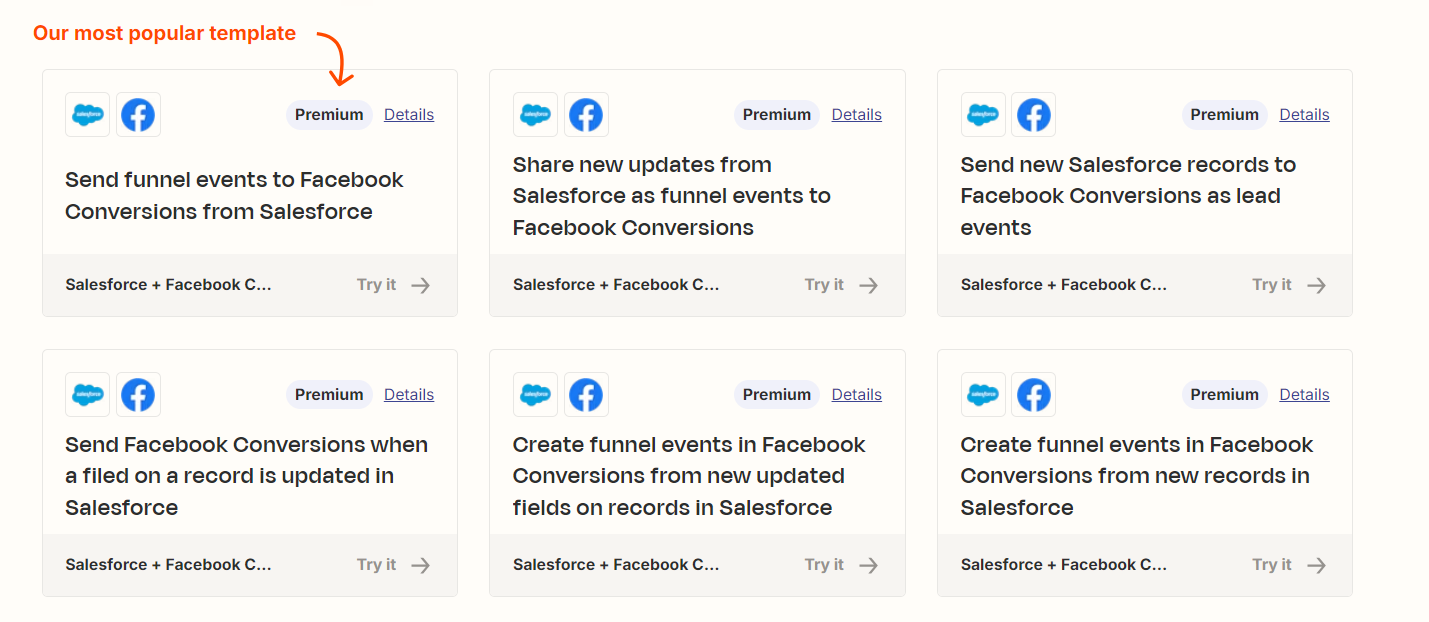
Tracking Lead Stages as Offline Conversions using HubSpot Ad Events (Lifecycle Stages)
Both HubSpot and Salesforce offer out-of-the-box integration with Facebook Ads for offline conversion tracking, but these features are not available in the starter plans of either CRM. To access this functionality, you’ll need to upgrade to higher-tier editions such as HubSpot Marketing Hub Pro/Enterprise or Salesforce Pardot. For users on CRM starter plans, Facebook recommends using Zapier to facilitate offline conversion tracking integration.
Using HubSpot as an example, the Marketing Pro Edition includes a feature called HubSpot Ad Events, which offers robust capabilities to track and optimise Facebook Ads performance. By syncing lead lifecycle changes back to Facebook Ads, you unlock enhanced optimisation and reporting through AI-powered machine learning, ensuring that your marketing investments yield measurable results.
HubSpot defines several lifecycle stages to help businesses track and manage the journey of a contact (lead) through the sales funnel. These stages include:
- Subscriber: A contact who has shown interest in your content and opted in to receive updates, typically by subscribing to a blog or newsletter.
- Lead: A contact who has demonstrated potential interest in your products or services, often by filling out a form or contacting your business.
- Marketing Qualified Lead (MQL): A contact identified by the marketing team as ready for sales outreach.
- Sales Qualified Lead (SQL): A contact vetted by the sales team and deemed ready for direct follow-up.
- Opportunity: A contact who has entered the sales pipeline and is considered a potential deal.
- Customer: A contact who has completed a purchase and become a paying customer.
These lifecycle stages allow businesses to better track and optimise their sales funnel, improving the effectiveness of Facebook Ads and other marketing efforts. If you are using HubSpot Starter, you need to map the lifecycle stages to Google Ads using Zapier as the bridge for offline conversion tracking.

First Party Audience Targeting for Facebook Ads
First-party audience targeting in Facebook Ads involves using data collected directly from your interactions with customers or visitors to create highly customised and relevant advertising campaigns. This approach leverages the first-hand information gathered by your business—whether from CRM systems, website analytics, mobile app usage, or other direct customer engagements—allowing you to craft more effective and personalised strategies.
Also known as CRM retargeting, first-party audience targeting enhances your Facebook Ads campaigns by utilising your CRM data to develop highly targeted ads based on detailed customer profiles. By taking advantage of your CRM’s segmentation features, you can build customer lists and target specific groups with personalised messaging. Additionally, you can exclude certain lists to avoid audience overlap and improve the overall efficiency of your campaigns.
With first-party targeting, you can upload your CRM data to Facebook Ads, which allows you to:
- Improve targeting by reaching known audiences directly or separately targeting cold traffic that has not yet engaged with your brand.
- Engage warm audiences who are already familiar with your brand by delivering tailored messages for more impactful campaigns.
Using this data to create more precise ad campaigns leads to better performance and results. Moreover, excluding specific audiences helps further refine your targeting, ensuring your ads are shown to the right people at the right time.
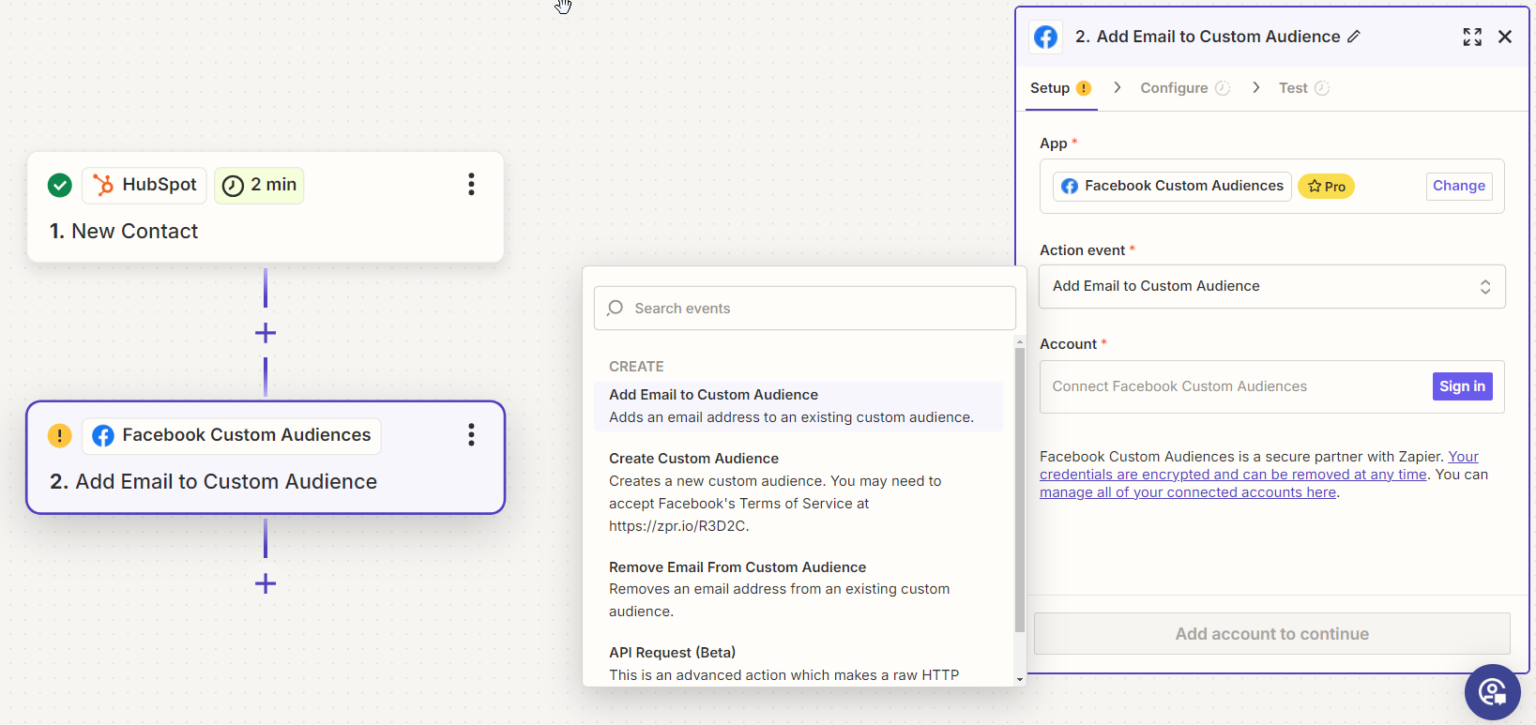
Types of Facebook Ads Audiences
Facebook Ads Matched Audiences: Facebook Ads Matched Audiences allow you to target specific groups by leveraging your own data, such as email addresses, company names, or job titles from your CRM. By uploading your customer or prospect lists to Facebook, the platform matches these contacts with Facebook users, enabling you to create highly targeted campaigns across Sponsored Content, Message Ads, and Text Ads. This feature allows you to reconnect with your existing customers, target potential leads, and retarget individuals who have already interacted with your brand—using Facebook‘s professional audience to drive better business results.
Website and App Retargeting for Facebook Ads: Facebook’s website and app retargeting uses data from users who visit your website or interact with your mobile app. By placing the Facebook Tag on your website, you can track which pages your visitors view and their actions, allowing you to build tailored remarketing lists. This enables you to deliver targeted ads to users who have previously engaged with your digital assets but have not yet converted, encouraging them to move further down the funnel.
Offline Data Import for Facebook Ads: Offline data import allows you to digitise information from offline interactions such as in-store purchases, event attendance, or direct mail responses. You can then upload this data into Facebook Ads to create more personalised campaigns targeting users based on their offline behaviour. This approach bridges the gap between online and offline engagements, providing a more comprehensive and cohesive marketing strategy that maximises your outreach potential across Facebook’s network.
CRM 1st-party Audiences - Using HubSpot as an example
Modern CRMs offer a wide range of capabilities to segment your contact database into targeted audiences that can be synced with Google Ads for advertising purposes. Let’s explore a few examples of audiences you can build using a CRM. For this demonstration, we’ve used HubSpot CRM as an example.
Website Users: Remarket to individuals who have visited your website, ensuring your ads reach those already familiar with your brand. These users are matched with their website cookie list, which is collected by the Facebook conversion tracking Insights tag or the HubSpot pixel.
Email Contact Lists: Retarget your contact/email lists by segmenting them into audiences based on specific behaviours, preferences, or demographics. For example, you can upload your customer list to upsell or exclude them from cold traffic campaigns.
Lookalike Segment Audiences: Build a cold audience of people who are most similar to your website visitors, email subscribers, and customer lists by matching them with Facebook‘s user database through hashed encryption.
Lifecycle Stage Audiences: Tailor your ads to different stages of the buyer’s journey. For instance, show introductory offers to new leads and premium service features to marketing-qualified leads (MQLs). Display top-of-the-funnel ads to new prospects who are not yet leads or past website visitors, and create specific adverts for each lifecycle stage of a new contact lead. Upsell to existing customers with targeted ads, encouraging repeat purchases or promoting complementary products and services. This approach ensures your advertising efforts are relevant and effective at every sales cycle stage.
Ads Interaction Audiences: You can segment contacts in lists based on their ads interactions in ad networks including Google Ads, Facebook Ads and Facebook Ads.
Ad interactions include when users click on your ads or submit a form after they engage with your ad. Each ads interaction filter represents a trackable ad interaction, such as identifying which contacts clicked through to your website from a specific Facebook Ads campaign
Event-Based Audiences: HubSpot’s event-based audiences allow you to target users based on their specific interactions with your website content, providing highly personalised and relevant marketing experiences.
Target users based on their interactions with your website content, such as viewers of a certain page, webinar sign-up attendees, or those who downloaded a particular resource. For example, send an email automatically using a workflow to contacts when they return to your website.
Geographic Audiences: Customise your ads based on the location of your audience to deliver region-specific offers or announcements using HubSpot properties such as city name or postal code to segment targeted lists.
Demographic Audiences: To effectively use Facebook Ads with HubSpot demographic targeting, start by collecting detailed demographic information from your audience, such as age, gender, location, and job title, through lead forms and CRM data integration. Next, create segmented lists in HubSpot based on these demographics, allowing for precise targeting. Sync these segmented lists with Facebook Ads to ensure your campaigns reach the desired demographic groups. Tailor your ad content to resonate with each segment by adjusting visuals, copy, and offers to match their specific preferences and needs.
Buyer Persona Audiences: You can segment your retargeting lists based on personas that you have created inside HubSpot to create more tailored ad content.
Hyper-Targeting Audiences:
Depending on the sizes of your audiences, you can overlay multiple audiences to create hyper-targeted audiences. Just remember that Facebook ad audiences do have minimum sizes due to privacy restrictions.
Using a Point of Sale (POS) Instead of a CRM for Offline Conversion Tracking
For businesses that operate primarily offline, such as service providers who generate leads online but complete sales offline, using a Point of Sale (POS) system for offline conversion tracking can be an ideal solution. Instead of relying on a CRM for sales tracking, integrating a POS system like Stripe enables you to monitor sales and conversions from the moment a lead receives a quote to the completion of payment. * Many CRM systems today include built-in POS functionality using Stripe, so this applies specifically when you are utilising the POS integration feature only.
Stripe as a POS Example for Service Providers
Stripe, a widely used POS solution, offers a range of services that are perfect for service-based businesses. For example, many service providers—such as consultants, contractors, or agencies—might engage with leads through initial consultations, and then provide a quote for the service. Once the quote is accepted, an online payment link can be generated via Stripe, allowing the customer to complete the transaction.
By integrating Stripe with Facebook Ads, you can track the entire sales cycle from lead generation to completed payments. This setup is especially useful for businesses that don’t use a full-fledged CRM but need to measure offline sales performance and link it back to their ad campaigns.
How Stripe Integration Works for Offline Conversion Tracking
- Lead Generation: Your business generates a lead through Facebook Ads—this could be via Lead Ads or website interactions.
- Quotation: Once the lead is nurtured, you send them a quote or proposal for your service. This can be done directly through Stripe, which can also store their payment details securely.
- Payment Completion: After the client accepts the quote, they can pay online using a Stripe payment link, completing the offline conversion.
- Offline Conversion Data: Stripe then records the payment as an offline conversion, which can be synced back to Facebook Ads via integration. This data is valuable for Facebook’s optimisation algorithms, allowing it to track not just lead submissions but actual revenue-generating sales.
Benefits of Using Stripe for Offline Conversion Tracking
- Seamless Online Payment Integration: Service providers can send quotes and receive payments entirely online through Stripe, simplifying the customer experience.
- Accurate Sales Attribution: By integrating Stripe with Facebook Ads, you can attribute actual sales revenue to specific ad campaigns, not just lead submissions.
- Improved Ad Optimisation: Facebook’s AI can learn which ads are leading to high-value transactions, allowing the platform to optimise future ads for better-performing audiences.
- No Need for a Full CRM: If your business operates without a CRM, using Stripe as your POS system provides a simple yet effective way to track and report on sales data without needing complex customer relationship management tools.
Setting Up Stripe Integration for Facebook Ads
To connect Stripe to Facebook Ads for offline conversion tracking, you can either use direct integration tools available in Stripe or rely on middleware like Zapier to sync data between the two platforms. This allows for the automatic updating of Facebook Ads with completed sales data, enhancing reporting and audience targeting capabilities.
By using a POS system like Stripe instead of a CRM for offline conversion tracking, service providers can streamline their sales processes, attribute offline sales accurately, and make better-informed decisions on where to allocate ad spend.
Conclusion
Integrating your CRM with Facebook Ads is a powerful way to unlock the full potential of your advertising campaigns. By connecting the two platforms, you can improve targeting, track offline conversions, and optimise ad spend based on lead quality and customer lifecycle data. Whether you’re a start-up using Zapier for a cost-effective solution or a more established company seeking to leverage premium CRM tools beyond starter editions of HubSpot or Salesforce, this integration can dramatically improve your advertising results and ROI.
The right integration method will depend on your business size, advertising budget, and technical capabilities. However, by understanding the options available—whether it’s using a marketing automation system, combining Zapier with native CRM tools, or even using Facebook‘s API—you can ensure your advertising is supported by data-driven decisions, providing a more personalised and effective customer experience.
Next Steps
📞 Ready to Unlock the Power of Facebook Ads CRM Integration?
Book a free consultation with our expert consultants and see how we can transform your Facebook advertising campaigns from cost-per-lead into revenue-generating machines. We’ll advise on all your CRM integration options and provide tailored strategic advice to supercharge your results. Take the first step toward the future of advertising today! 🚀